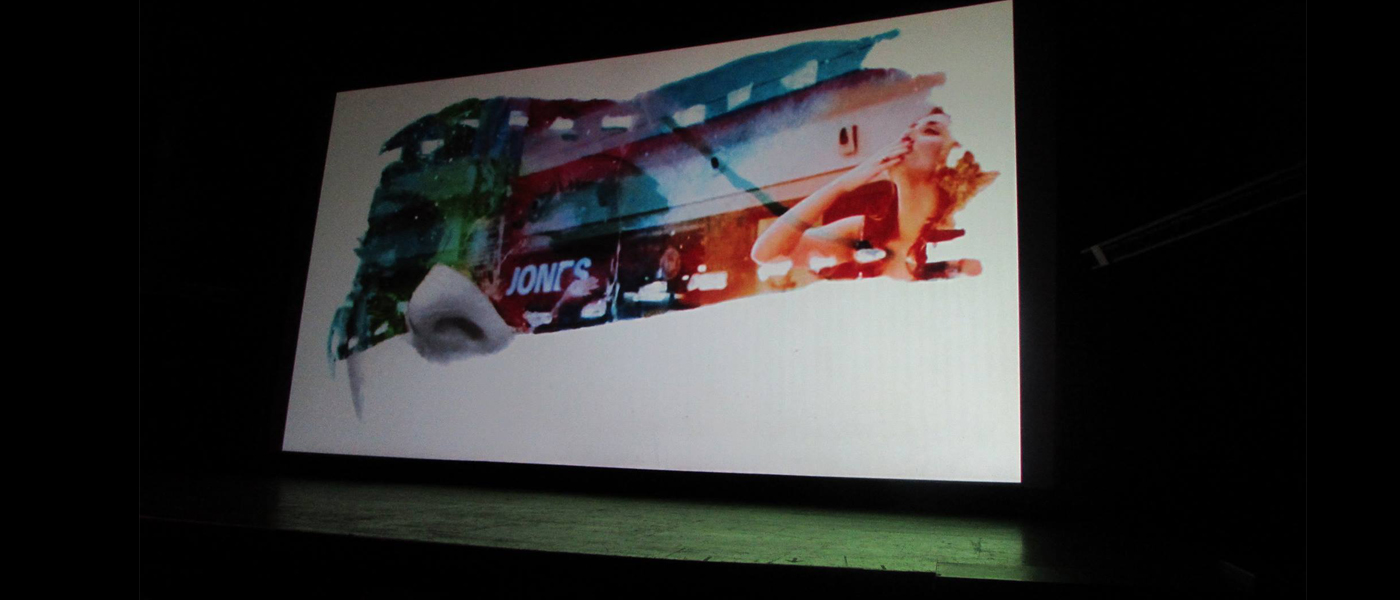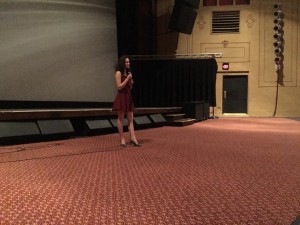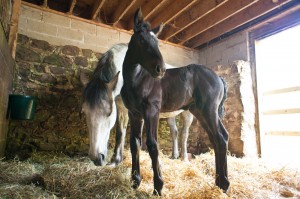For those who missed Spring Fest 2015 at The Palace Theatre: You missed out on a lot. Even attending one day, Sunday, wasn’t enough.
Saturday, April 25, was filled with documentaries (Northside, At What Cost, and Million Dollar Mayor) and a sneak peak at The Undersigned, a television show pilot being filmed in Syracuse.
The One Take SUPER 8 Festival took place at 10 p.m. that evening, an approximate 45-minute stretch of selections of entries from previous years.
May 26 featured a documentary, Monster Mansion Memories, which was written, produced and directed by Andy Wolf. The culminating feature: King Lee, a fictitious film based on the exploits of former mayor Lee Alexander.
Sunday’s short films took place at 1 p.m., and they were a definitive highlight. By short films, we include short shorts (they can last from seconds to a couple of minutes long) and the features that conclude before they are considered full-length feature films.
Throughout history, the use of shorts have been utilized with other features. Laurel and Hardy or Charlie Chaplin were familiar faces that graced the silver screen. Walt Disney and Looney Tunes have effectively constructed the art of storytelling into animated segments. Disney and Pixar have brought the animated short back, creating shorts before the features. Being a fan of Pixar, whose feature lengths are wonderfully told, and the consistent shorts are often better than blockbusters or even trilogies that have been/will be adapted for the screen.
“Shorts are very difficult to make,” stated Mike Massurin, Executive Director of Syracuse International Film Festival (SYRFILM). “The director and writers have to effectively tell their story in a short amount of time.”
Massurin said word of mouth had been exceptional this year. The previous year, when SYRFILM made the announcement and encouraged local filmmakers to participate, there was a great response. “This year, we didn’t have to put anything out. This year we chose seven films. There were 40 submissions that we had to choose from. Filmmakers were asking to participate before there was publicity.”
That says a lot about the arts culture of Syracuse.
The seven selected shorts this year varied in length, ranging from 2 to 25 minutes. Each were significantly different. And, to burst the bubbles of those with short attention spans, the heartiness of the films were thought provoking and deep.
Here are the short films, in short:
No Riders by Erica Francis (2 minutes)
The silent film, which was originally viewed as a “commercial” was the only short film without an ambiguous ending. Although we see the curious child walk away with a soda, there are a few questions that may arise when wondering what happens next.
The black-and-white treat was filmed in Kansas. Francis said that the gentleman who owned the property had an affinity for classics. These classics did include vehicles, emphasizing on the T-Model Ford truck in the film, and his personal reconstruction of an old gas station.
The film told a story of a very humorous relationship of a child and a young adult. She was the antagonizing protagonist who got what she wanted.
Crucible by Stephen Long (4 minutes)
Long thanked the Gear Factory and Lipe Art Park (to name a couple) for participating with this production after the short was presented.
After the four-minute story, Long had me wanting more. It makes sense, considering Crucible was part of a longer script that he hopes to produce one day.
After a quick meeting outside of a brick warehouse, the action sequence is quick and fast. The lighting is dark, but the shadows are not overwhelming (the actors’ faces can clearly be seen). The sequence is fast, and the perceived “thief” gets away at the end.
Garrett Heater, whose character’s intentions are unknown, ends the film with kneeling down and picking up a piece of art, staring at it before the credits come up.
I have a personal preference for ambiguous endings, and this satisfying end has my brain wanting more.
Making Waves by Sydney Schwab (4 minutes)
Schwab, a high school student, was the youngest participant this year. She’s off to a great start.
She tackled high school dating life, and it was hard not to laugh. I wasn’t a laughing at her, but with her. The truth of awkward high school dating, asking someone out, and preparing for the date was exaggerated a little, but the emphasis was appropriate.
The relationships were blatantly obvious: the male and female protagonists, the family and friend advice of the supporting characters showed truth with “trying to help.” Those relationships drove the story, which made the short easy to relate to.
Schwab credited the side-by-side perspectives of both characters preparing for the date to the tactics used in the Jump Street films. Film inspired her, and she utilized a tactic that many directors used.
The Haircut by Alexis O. Korycinski (14 minutes)
The short was filled with familiar faces from Banshee, Castle, and True Blood to name a few. The actors weren’t distracting, however, and they didn’t take away from the purpose of the story.
The main character, Amy, is hesitant to get a haircut at the beginning of the film. She goes to a party, talks with her friends, who are supportive of her. At the dinner table, her family members are hesitant. Come to find out, she is enlisting in the military.
The perceived girly-girl goes through a lot in the 14-minute film. The sexism that Amy faces are thrown in her face, and she doesn’t back away. She faces oppression and finally goes through with getting her hair cut, which can be heard, but not seen, when the credits roll.
It’s a very poignant film, proving that her other antagonists are the other cadets than her direct superior, who is tough on both the men and women recruits.
The Man in the House by Chris Markwardt (17 minutes)
It’s difficult to pick a favorite out of the seven films, but Markwardt’s The Man in the House deserves a standing ovation … even if I am the only one standing. The concept started out as a drawing, according to the writer/director.
To go back to my tweet: This film is what nightmares are made of, so dark and ominous, but it is so beautifully crafted. If The Twilight Zone was an entity itself and had terrors, this would be the cause for pre-bedtime anxiety, a reason to check under the bed and in the closet, a reason to keep the blanket pulled over its head.
When asked about the meaning behind his film, Markwardt looked at the audience member and asked, “What do you mean?” He chuckled a little bit. He continued, stating that he had five different explanations for the short, but he didn’t explain any of them. He wanted the audience to question the reality that he created and come up with their own explanations.
My Little Bubbles by Michael Pizzano (17 minutes)
I was happy to tweet — “@filminsyracuse: My Little Bubbles killer dog emulates the Monty Python rabbit, makes you question your sanity.” — before Pizzano explained to the audience that he “may have watched too much Monty Python as a child.” Unfortunately, this is a spoiler, but it doesn’t take away from the short.
It’s never explained why the five characters were lost in the woods. It never explains what happens to the first character who is already dead by the time the story begins. It’s never explained why the cute little fluff ball of a dog outwits and savagely consumes the people he is trapped with.
The characters are cartoonish, but it works out very well due to their consistency and commitment to the roles. And the 17-minute parable pays homage to Dr. Seuss and The Brothers Grimm and a little bit of Aesop for good measure. The latter is not a stretch, because there is a lesson to be learned: Never underestimate the primal instincts of a little white dog that can essentially be carried around in a purse.
The Wish Horse by Lisa Ford (25 minutes)
Ford respects and appreciates the use of an ambiguous ending. “The ending was done on purpose,” she said. The audience is left questioning the result of the incident, the fates of the brother and sister.
The Skaneateles-based director gave the attendees of the festival a slice that could very well be part of a bigger production. In terms of television, based on length of the film, it could have been an episode of a series.
As the film ends and the two protagonists walk into the woods together, there is a sense of hope. The little girl, because of her age, is naive and cannot fully comprehend the unfortunate living situation that she in, is being looked after by her older brother. Although he accepts the negativity and embodies a potential powder keg of rage, he understands the predicament.
There are many literary elements that come into play, Joseph Campbell’s A Hero with a Thousand Faces can be referenced when considering the boy, and that same character is tested through the 25-minute duration. As he wants to stray, act his age and learn from decisions both good and bad, the protagonist returns to being the adult and accepts responsibility.
Every character has a distinct vulnerability, an Achilles Heel per se, and the actors don’t break from their roles. The film is raw and painful to watch, but these qualities yield its honesty and beauty.














